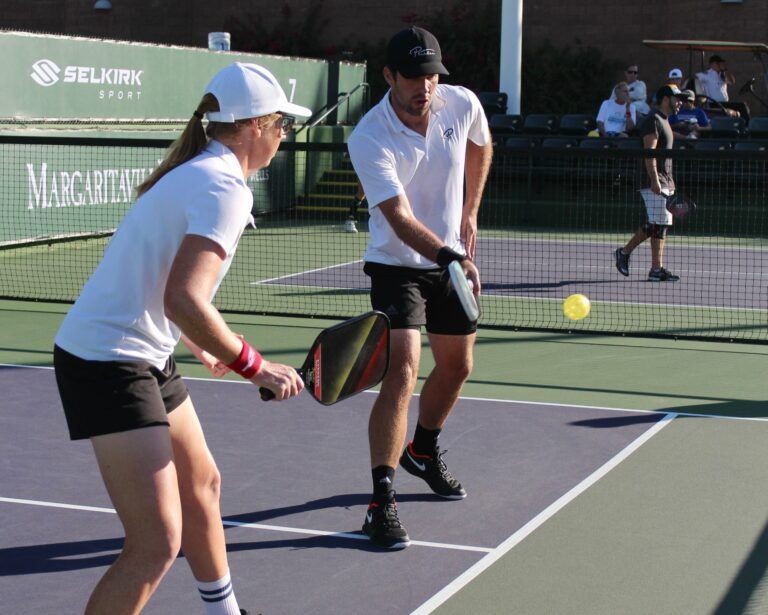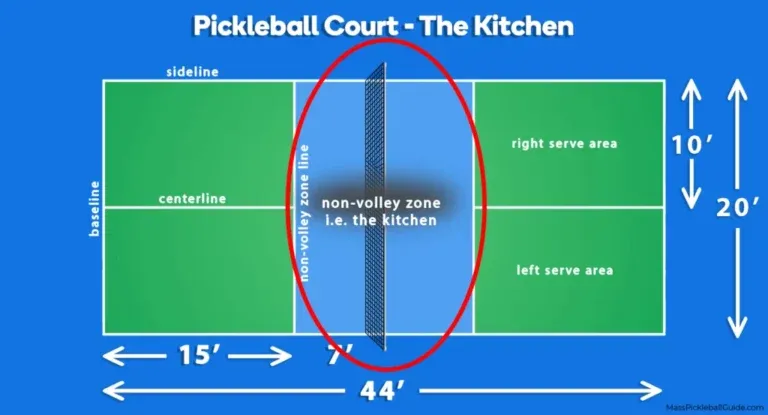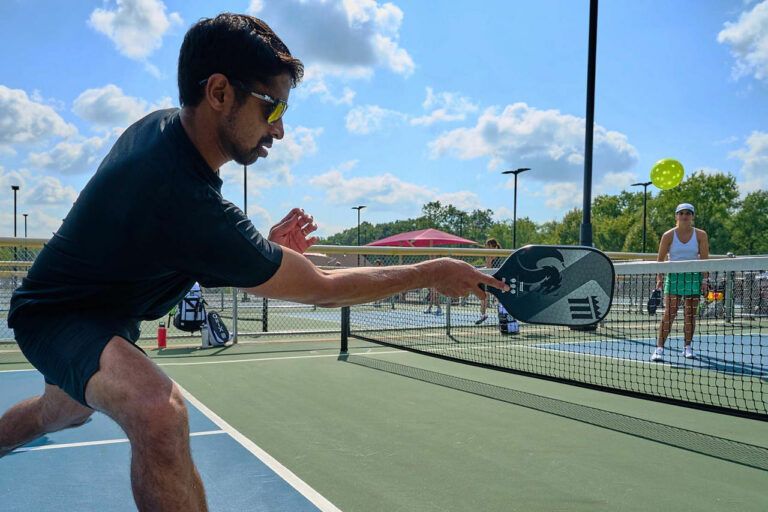Foundational Pickleball doubles strategies: building a solid doubles game
Developing a solid foundation in pickleball doubles is akin to constructing a sturdy building; the stronger the base, the more resilient the structure. The essential elements of teamwork, communication, and court positioning play pivotal roles in establishing this foundation.
The importance of positioning: controlling the court
Mastering court positioning is fundamental. One popular formation is the "two up, two back" strategy, where both players position themselves at the net or in the back court, depending on the situation. This allows for versatile attack and defense:
- Two Up: When both players advance to the kitchen line, they can dominate offensive plays, controlling the game by posing a constant threat to opponents with aggressive volleys.
- Two Back: This positioning focuses on powerful serves and returns, allowing each player to cover more ground.
The "triangle rule" emphasizes that each partner creates a triangle with the ball ensuring that no gaps are left open for opponents to exploit. Getting to the Non-Volley Zone (NVZ) line quickly after the return of serve is crucial for effective plays. Introducing the idea of "no man's land", where players get caught in the middle of the court, underscores the importance of maintaining clear positioning and avoiding unnecessary vulnerabilities.

Serving with purpose: setting up the point
A strategic serve sets the tone for each point. Serving deep and accurately into the opponent’s court applies immediate pressure. Targeting their weaker side, especially their backhand, can create advantageous scenarios. Additionally, using different spin variations like topspin and sidespin adds unpredictability to your serve, compelling opponents to adjust their strategies accordingly.
It's essential to understand the double bounce rule: after the serve, each team must allow the ball to bounce once before playing it. This rule promotes longer rallies and strategic shot-making, particularly useful for setting up tactical plays.
Returning with confidence: neutralizing the serve
The return of serve is a moment where players can shift the game’s momentum. A deep return keeps the serving team back, minimizing their offensive opportunities. Exploring slice returns, which absorb the opponent's power and create time to move forward, can put additional pressure on them.
Placement strategies, such as consistently returning the ball down the middle or to a specific opponent's weaker side, can lead to forced errors. The debate surrounding the second shot drop is also significant; while this can be effective at lower skill levels for gaining control, it's typically less recommended for advanced players due to prompt returns that can allow the opposing team to dominate the NVZ.

Intermediate strategies: elevating your doubles game
Once you've grasped the foundational strategies, it's time to elevate your game. Intermediate strategies center around tactical shot selection, the intricacies of dinking, and using positioning to exploit opponents' weaknesses.
Dominating the kitchen: dink, volley, and control
Establishing a strong presence at the NVZ, or kitchen line, cannot be overstated. A well-executed dink requires precision and placement. This soft shot can draw opponents into a less advantageous position, effectively allowing you and your partner to maintain control.
Effective volleying techniques also play a critical role in marrying aggression with ground control. Utilizing firm wrist volleys on hard drives and roll volleys for slower shots can keep the pressure on your opponents. Proper footwork at the kitchen line, using slide steps and drop steps, ensures you can move fluidly and respond to fast exchanges.

Strategic shot selection: placement over power
One of the most crucial components of intermediate play is recognizing that placement often trumps power. By focusing on forcing errors through accurate shot placement, you can exacerbate your opponents' weaknesses.
- Targeting the backhand: Often a weaker side, this can lead to mishits or forced errors.
- Hitting deep down the middle: Maximizes your margin for error and creates confusion, as both opponents must react quickly.
- Cross-court dinking: Preferred for its margin of error, this should be your go-to but also incorporate deviations when appropriate.
Introducing poaching: an aggressive approach
Poaching is an aggressive tactic that can yield substantial rewards. It involves one partner intercepting a shot intended for the other, which can disrupt opponents’ strategies.
Strong communication and timing are crucial to executing this strategy effectively; if done at the right moment, it can lead to winning points. However, be aware that if your poach is anticipated, it leaves your partner vulnerable.
Advanced strategies: fine-tuning your doubles game
As players reach an advanced level, the focus shifts to fine-tuning strategies that emphasize spin, adaptability, and mental fortitude characteristics that truly distinguish elite players from the rest.

Spin techniques: adding deception and control
Incorporating various spins into your shots adds an element of unpredictability. Topspin can create higher bounces, while backspin can cause the ball to drop sharply, providing tactical advantages in rallies.
Understanding how to utilize these spins effectively can elevate your shot placement. For instance, using backspin on a dink to make it difficult for your opponents to attack can lead to errors.
Countering opponent strategies: adapting your game plan
Being able to adapt your strategies based on your opponents' gameplay is essential for advanced players. Each match brings unique dynamics, and recognizing when to switch between aggressive play and patient defense can drastically change the outcome of a game.
Analyzing your opposing team and adjusting your game plan whether it's incorporating lobs or changing up your dinking approach can lead to enhanced performance.
Adapting to different court surfaces: indoor vs. outdoor play
Each court surface offers distinct playing characteristics. Indoor courts tend to have less wind and consistent bounces, while outdoor courts can introduce factors like sunlight and environmental conditions that can affect playability. Understanding these dynamics and making necessary adjustments will help players excel regardless of the setting.
The mental game: staying sharp and focused
Finally, the mental aspect of pickleball should never be underestimated. Patience and positivity are crucial; maintaining focus during tense moments can help you and your partner remain cohesive and reduce errors. Effective communication fosters a strong team dynamic, crucial in competitive settings.
Resources for continued improvement
Continued growth in pickleball doubles requires practice, education, and community engagement. Resources such as drills, instructional videos, and participation in local clubs can propel you forward.
Practice drills for doubles success
Engaging in specific practice drills can significantly enhance performance:
- Dinking drills: Focus on developing consistency and accuracy.
- Third shot drills: Target driving or executing drop shots effectively.
- Positioning drills: Practice moving to the NVZ quickly and efficiently.
Focus on these drills to ensure you and your partner are prepared for competitive play.
Additional resources: expand your knowledge
Engaging with diverse resources enhances your understanding and skills:
- Videos: Platforms like YouTube have extensive materials from professional players.
- Articles and books: Literature focusing on tactics and strategies can provide deeper insights into advanced concepts.
- Coaches and local communities: Joining clubs or hiring a coach can offer tailored feedback and foster growth in specific areas.
In conclusion, the journey to mastering pickleball doubles strategies involves a continuous cycle of learning, practice, and adaptation. Strategies that engage communication, tactical shot selection, and a strong positioning framework can considerably enhance your games. Embracing these approaches not only aids in the quest for victory but also enriches your enjoyment and appreciation of the sport. Being part of a doubles team is not merely about individual prowess; it's about the synergy created through effective partnership and shared goals. By understanding these strategies, players can optimize their gameplay and unlock their full potential on the court.










